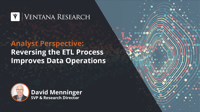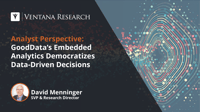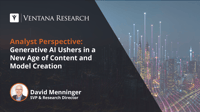
The 2023 Ventana Research Buyers Guide for Augmented Analytics research enables me to provide observations about how the market has advanced.
Topics: Analytics, AI & Machine Learning, Augmented Analytics


The 2023 Ventana Research Buyers Guide for Augmented Analytics research enables me to provide observations about how the market has advanced.

I am happy to share insights gleaned from our latest Buyers Guide, an assessment of how well vendors’ offerings meet buyers’ requirements. The Ventana Research 2023 Analytics and Data Buyers Guide is the distillation of a year of market and product research by Ventana Research. Drawing on our Benchmark Research, we apply a structured methodology built on evaluation categories that reflect the real-world criteria incorporated in a request for proposal to Analytics vendors supporting the spectrum...

The 2023 Ventana Research Buyers Guide for Analytics and Data research enables me to provide observations about how the market has advanced.

Organizations are continuously combining data from diverse and siloed sources for analytical, artificial intelligence and machine learning projects. As the volume of data grows, it becomes challenging for organizations to manage and keep current to extract valuable insights in a timely manner.

At one point, analytics and business intelligence were considered non-mission critical activities. One of the primary concerns in designing analytics systems was to ensure they didn’t interfere with or draw computing resources away from operational systems. But today, analytical systems are integral to many aspects of operations. More than 9 in 10 participants in our Analytics and Data Benchmark Research reported analytics had improved activities and processes. However, most analytics and BI...

If I had a magic wand, I would want to add scenario evaluation to all business intelligence tools on the market. I have previously written about the need to make intelligent decisions with decision intelligence. The data and analytics markets have evolved so that organizations have far greater capabilities to utilize data in decision-making processes. While there is some convergence around the concept of decision intelligence, there are still several “islands” of decision-making. Analyzing...

The current market landscape of data and analytics is undergoing rapid evolution, presenting organizations with a wide array of challenges and opportunities. As data sources and warehouses steadily migrate to the cloud, a significant number of organizations still depend on conventional tools. This reliance on legacy systems hinders the seamless accessibility and adoption of analytics and business intelligence within business processes. Organizations are increasingly turning to embedded...

MicroStrategy is a long-standing business intelligence and analytics vendor that operates worldwide. Founded in 1989, this publicly traded company with hundreds of millions of dollars in revenue recently held its first in-person conference since prior to the pandemic. Similar to previous in-person events, the event was well attended by about 2,000 attendees and exhibitors. The theme, “MicroStrategy ONE,” is a way to explain the breadth of capabilities the company offers. The breadth of the...

Artificial intelligence (AI) has evolved from a highly specialized niche technology to a worldwide phenomenon. Nearly 9 in 10 organizations use or plan to adopt AI technology. Several factors have contributed to this evolution. First, the amount of data they can collect and store has increased dramatically while the cost of analyzing these large amounts of data has decreased dramatically. Data-driven organizations need to process data in real time which requires AI. In addition, analytics...

Generative AI is a class of artificial intelligence used to generate new, seemingly real content. Broadly speaking, AI has traditionally been used to identify patterns in data and apply those patterns to categorize and predict behaviors. For instance, it can organize customers into groups (or clusters) with similar characteristics, or predict which customers are most likely to respond to certain offers.